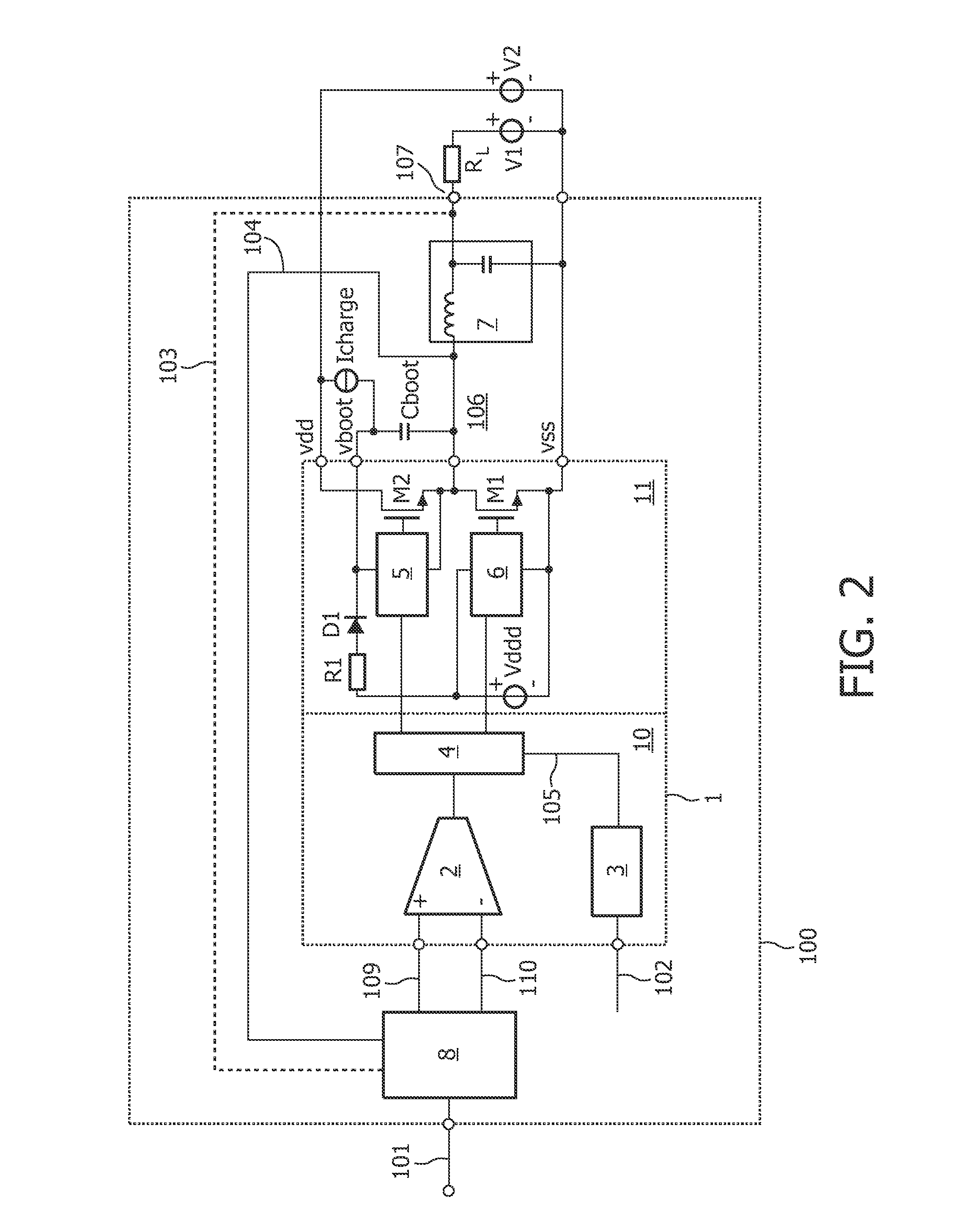Electronic device for self oscillating class d system
a self-oscillating, electronic device technology, applied in amplifiers, amplifiers with semiconductor devices/discharge tubes, amplifiers, etc., can solve the problems of severe interference of circuitry functionality, undesired offset of electronic components, etc., to avoid additional disturbance of duty cycles, smooth start-up, and without undesired audible effects
- Summary
- Abstract
- Description
- Claims
- Application Information
AI Technical Summary
Benefits of technology
Problems solved by technology
Method used
Image
Examples
first embodiment
[0023]FIG. 1 shows a simplified block diagram of a self-oscillating class D system according to the prior art. The self-oscillating class D system 100 includes an integrated circuit usually designated as an integrated power comparator 1.
[0024]The integrated power comparator 1 has substantially the same behavior as a comparator, except that the output signal 106 of the integrated power comparator 1 is modulated and rapidly switched between Vdd and Vss (ground) in accordance with an audio input signal 101. The supply voltage Vdd is provided by voltage source V2. The rapid switching between supply lines Vdd and Vss enables the integrated power comparator 1 to provide a current of several amperes on the output pin 106. The output signal on node 106 is typically modulated by pulse width modulation (PWM).
[0025]The self-oscillating class D system 100 of FIG. 1 is configured as a closed loop. Therefore, the class D system 100 further includes a discrete loop filter 8 as shown in FIG. 1. The...
second embodiment
[0033]FIG. 2 shows a simplified schematic of the prior art that is substantially similar to FIG. 1. However, in order to overcome the hang up problem during a start-up of the self-oscillating class D system shown in FIG. 1, this conventional solution suggests to include an additional current source Icharge between the first end of the boot capacitor Cboot, i.e. vboot, and Vdd. According to this principle, the boot capacitor Cboot is precharged by the current source Icharge before the output power stage 11 is switched on. This principle is only applicable to supply voltages having the following relation:
V2>2×(Vtr+Vcs)
wherein Vtr is the minimum voltage for the charge guard protection across Cboot to release the high side driver (e.g. 9 V) and Vcs is the voltage drop across the current source Icharge (e.g. 1 V). Accordingly, only if V2 is greater than 20 V, the current source Icharge for charging the boot capacitor Cboot may be successfully applied. However, most of the applications re...
PUM
 Login to View More
Login to View More Abstract
Description
Claims
Application Information
 Login to View More
Login to View More - R&D
- Intellectual Property
- Life Sciences
- Materials
- Tech Scout
- Unparalleled Data Quality
- Higher Quality Content
- 60% Fewer Hallucinations
Browse by: Latest US Patents, China's latest patents, Technical Efficacy Thesaurus, Application Domain, Technology Topic, Popular Technical Reports.
© 2025 PatSnap. All rights reserved.Legal|Privacy policy|Modern Slavery Act Transparency Statement|Sitemap|About US| Contact US: help@patsnap.com



